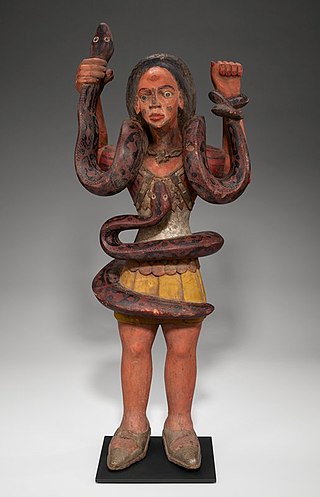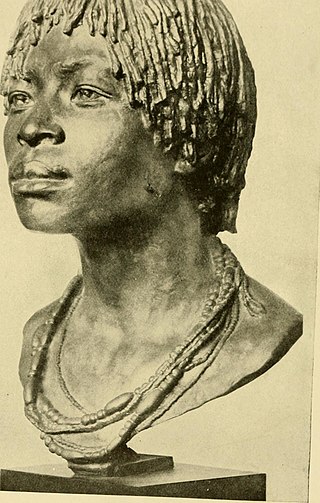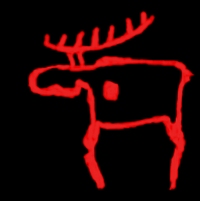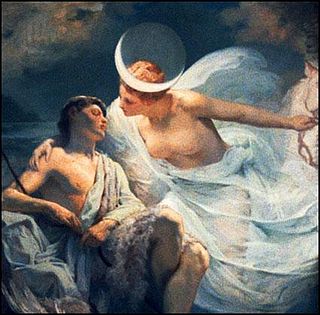A creator deity or creator god is a deity responsible for the creation of the Earth, world, and universe in human religion and mythology. In monotheism, the single God is often also the creator. A number of monolatristic traditions separate a secondary creator from a primary transcendent being, identified as a primary creator.

A Simbi is a water and nature spirit in traditional Kongo spirituality, as well as in Hoodoo.

Odinani, also known as Odinala, Omenala, Odinana, and Omenana, is the traditional cultural belief and practice of the Igbo people of south east Nigeria. These terms, as used here in the Igbo language, are synonymous with the traditional Igbo "religious system" which was not considered separate from the social norms of ancient or traditional Igbo societies. Theocratic in nature, spirituality played a huge role in their everyday lives. Although it has largely been synchronized with Catholicism, the indigenous belief system remains in strong effect among the rural, village and diaspora populations of the Igbo. Odinani can be found in Haitian Voodoo, Obeah, Santeria and even Candomblé. Odinani is a pantheistic and polytheistic faith, having a strong central deity at its head. All things spring from this deity. Although a pantheon of other gods and spirits, these being Ala, Amadiọha, Anyanwụ, Ekwensu, Ikenga, exists in the belief system, as it does in many other Traditional African religions, the lesser deities prevalent in Odinani serve as helpers or elements of Chukwu, the central deity.

A mother goddess is a major goddess characterized as a mother or progenitor, either as an embodiment of motherhood and fertility or fulfilling the cosmological role of a creator- and/or destroyer-figure, typically associated the Earth, sky, and/or the life-giving bounties thereof in a maternal relation with humanity or other gods. When equated in this lattermost function with the earth or the natural world, such goddesses are sometimes referred to as the Mother Earth or Earth Mother, deity in various animistic or pantheistic religions. The earth goddess is archetypally the wife or feminine counterpart of the Sky Father or Father Heaven, particularly in theologies derived from the Proto-Indo-European sphere. In some polytheistic cultures, such as the Ancient Egyptian religion which narrates the cosmic egg myth, the sky is instead seen as the Heavenly Mother or Sky Mother as in Nut and Hathor, and the earth god is regarded as the male, paternal, and terrestrial partner, as in Osiris or Geb who hatched out of the maternal cosmic egg.

Candomblé Bantu is one of the major branches (nations) of the Candomblé religious belief system. It developed in the Portuguese Empire among Kongo and Mbundu slaves who spoke Kikongo and Kimbundu languages. The supreme and creative god is Nzambi or Nzambi a Mpungu. Below him are the Jinkisi or Minkisi, deities of Bantu mythology. These deities resemble Olorun and the other orishas of the Yoruba religion. Minkisi is a Kongo language term: it is the plural of Nkisi, meaning "receptacle". Akixi comes from the Kimbundu language term Mukixi.

The Kongo people are a Bantu ethnic group primarily defined as the speakers of Kikongo. Subgroups include the Beembe, Bwende, Vili, Sundi, Yombe, Dondo, Lari, and others.
Palo, also known as Las Reglas de Congo, is an African diasporic religion that developed in Cuba during the late 19th or early 20th century. It arose amid a process of syncretism between the traditional Kongo religion of Central Africa, the Roman Catholic branch of Christianity, and Spiritism. An initiatory religion practised by paleros (male) and paleras (female), Palo is organised through small autonomous groups called munanso congo, each led by a tata (father) or yayi (mother).

Finnic paganism was the indigenous pagan religion in Finland, Karelia, Ingria and Estonia prior to Christianisation, the religion was native to the Baltic Finnic peoples. It was a polytheistic religion, worshipping a number of different deities. The principal god was the god of thunder and the sky, Ukko; other important gods included Jumo (Jumala), Ahti, and Tapio. Jumala was a sky god; today, the word "Jumala" refers to all gods in general. Ahti was a god of the sea, waters and fish. Tapio was the god of forests and hunting.

Philippine mythology is rooted in the many indigenous Philippine folk religions. Philippine mythology exhibits influence from Indonesian, Hindu, Muslim, Shinto, Buddhist, and Christian traditions.

The Kalûnga Line in Kongo religion is a watery boundary between the land of the living and the spiritual realm of the ancestors. Kalûnga is the Kikongo word "threshold between worlds." It is the point between the physical world and the spiritual world. It represents liminality, or a place literally "neither here nor there." Originally, Kalûnga was seen as a fiery life-force that begot the universe and a symbol for the spiritual nature the sun and change. The line is regarded as an integral element within the Kôngo cosmogram.

Nyambe is the Supreme God, Sky Father, and God of the Sun across numerous traditional Bantu religions.

Bantu religion is the system of beliefs and legends of the Bantu people of Africa. Although Bantu peoples account for several hundred different ethnic groups, there is a high degree of homogeneity in Bantu cultures and customs, just as in Bantu languages. Many Bantu cultures traditionally believed in a supreme god whose name is a variation of Nyambe/Nzambe.

Nzambi a Mpungu is the Supreme God, eternal Sky Father and God of the Sun (fire) in traditional Kongo spirituality. His female counterpart is Nzambici, the Sky Mother and Goddess of the Moon. Among other Central African Bantu peoples, such as the Chokwe, and in the Kingdom of Ndongo, Nzambi Mpungu was also called Kalunga, the god of fire and change. This may have a connection to an element of Bakongo cosmology called Kalûnga. It was seen as the spark of fire that begot all life in the universe. After Portuguese colonization, Nzambi Mpungu became synonymous with the Christian God and existed chiefly as the Creator God.

A lunar deity or moon deity is a deity who represents the Moon, or an aspect of it. These deities can have a variety of functions and traditions depending upon the culture, but they are often related. Lunar deities and Moon worship can be found throughout most of recorded history in various forms.

The Kongo cosmogram is a core symbol in Bakongo religion that depicts the physical world, the spiritual world, the Kalûnga line that runs between the two worlds, the sacred river that forms a circle through the two worlds, the four moments of the sun, and the four elements.

Kongo religion encompasses the traditional beliefs of the Bakongo people. Due to the highly centralized position of the Kingdom of Kongo, its leaders were able to influence much of the traditional religious practices across the Congo Basin. As a result, many other ethnic groups and kingdoms in West-Central Africa, like the Chokwe and Mbundu, adopted elements of Bakongo spirituality.

Mfinda is a spiritual concept of the forest in Kongo religion.













